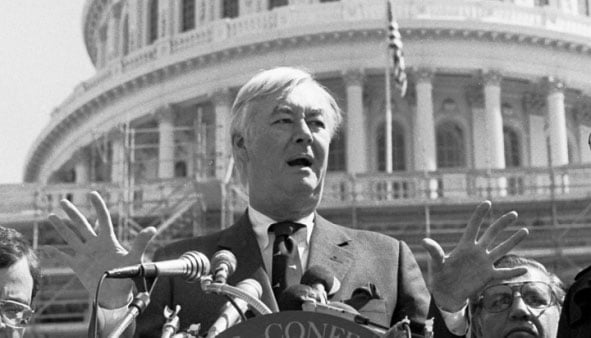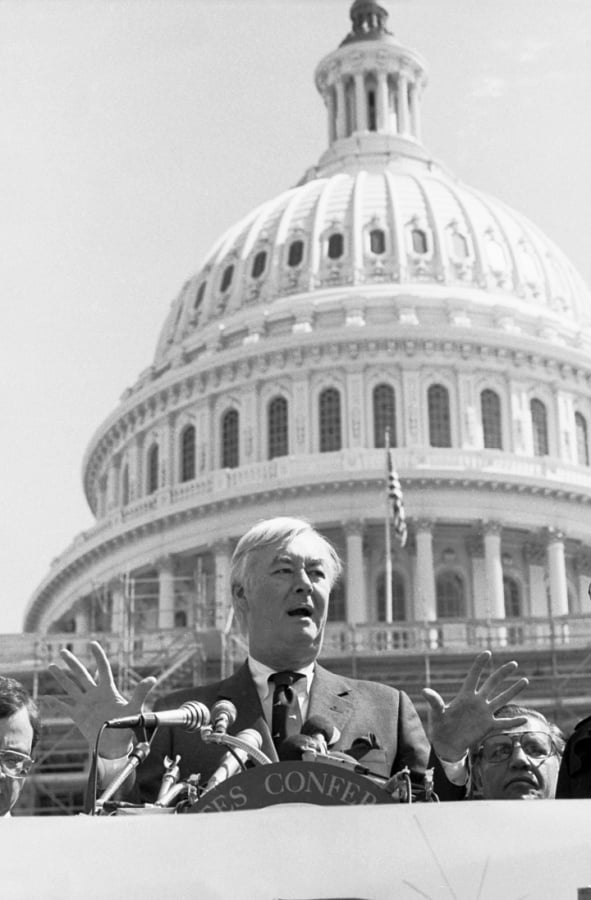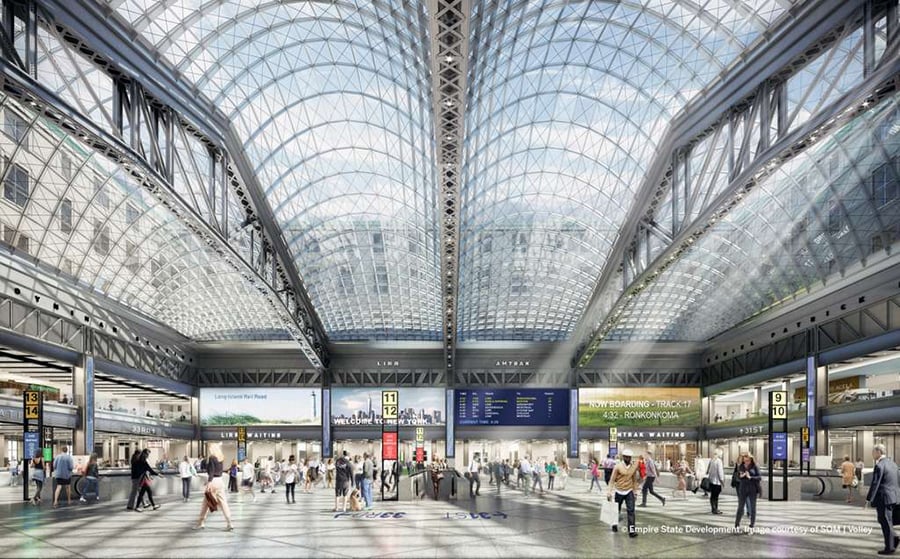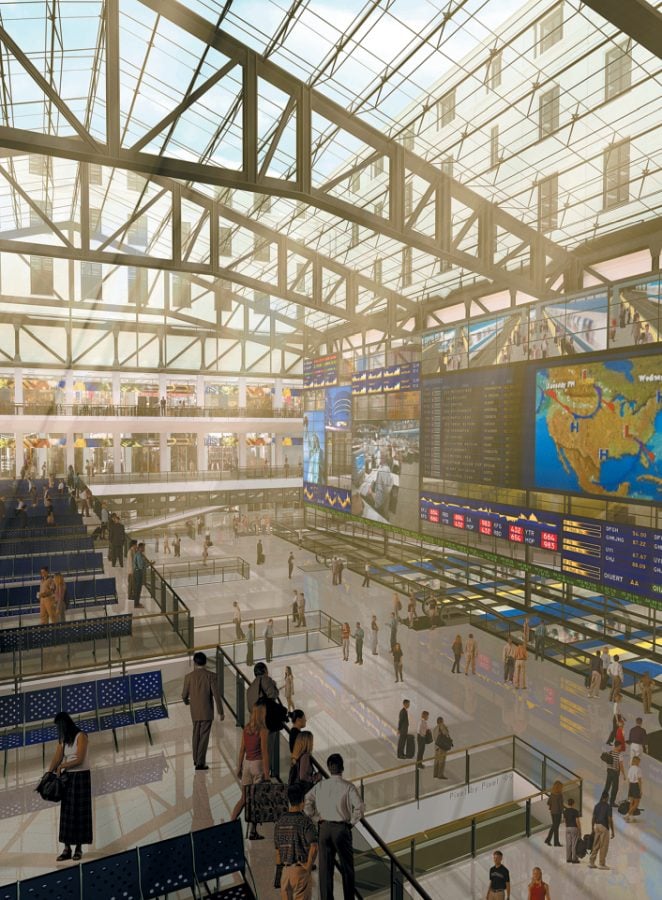
February 27, 2020
From the Metropolis Archives: The Senator of Design
Originally published in 2000, this article profiles Senator Daniel Patrick Moynihan as he prepared to retire from the Senate and reviews his legacy as a champion of great American architecture.

“From the Metropolis Archives” republishes old Metropolis print articles not available anywhere else on the web. (See the inaugural post here.) Benjamin Forgey’s 2000 profile of Daniel Patrick Moynihan provides an overview of the senator’s work as an advocate for good public design at the end of his career. Today, when forward-thinking public design is under fire from the White House, it’s worth taking a look back at the man behind so much beloved federal architecture.
It is late in the afternoon of a busy legislative day in the United States Senate. The bitterly divisive issue of trade relations with China is on the floor, and, as is often the case, New York senator Daniel Patrick Moynihan has been in the middle of the action. He favors opening our relations with the People’s Republic, and when I arrive for an interview at his cozy hideaway office inside the Capitol building, he seems predisposed to continue speaking about the issue-almost as if he were still on the Senate floor and I had a vote to cast on the opposing side.
The subject of our meeting is Moynihan’s involvement with federal architecture. Or—let me put this as precisely as I can—his extraordinary, resourceful, and exceedingly effective long-term advocacy of excellence in government architecture, landscape architecture, urban design, infrastructure, and planning. In nearly four decades in Washington, Moynihan, now 73, has instituted guidelines for federal architecture; spearheaded the rebuilding of Pennsylvania Avenue, including the Federal Triangle; pushed the new Penn Station project relentlessly forward; and secured funding and built coalitions for numerous preservation projects. Peg Breen, president of the New York Landmarks Conservancy, one of the legions of design-related agencies that have enjoyed Moynihan’s tireless support, says she has been closing all her recent letters to the senator with the plaintive query, “What are we going to do without you?” That question occurred to a lot of architects, preservationists, city planners, and longtime observers of federal design and planning policies two years ago when Moynihan suddenly announced his intention to retire from the Senate this month, after 24 years.
But for the moment Moynihan’s mental adrenaline is still pumping from the China confrontation on the Senate floor. Sitting crosslegged in a traditional wing chair in a book-filled room that could be a scholar’s home library, the Senate’s acknowledged intellectual embarks on a looping journey through recent Asian history. You can be certain it is going to end up on point, and it does: if the United States fails to take this action, “it would be as fateful a decision as we have made in the postwar period.” But it is the stops along this conversational way that are truly arresting, including a hilariously pointed description of Tiananmen Square: “two enormous flagpoles and two vast portraits of two hirsute nineteenth-century Germans-Mr. Marx and Mr. Engels—with young people running around to the dot-com shops.”.
During this informed, entertaining disquisition, I think again about the rarity among politicians of Moynihan’s passion for architecture, and how seamlessly he fits it into a political life overflowing with weightier responsibilities. The secret is that, to Moynihan, aside from the gravest matters of war, peace, and social stability, other issues simply are not more important than the building and rebuilding of our cities. In his office, this has been a daily fact of life. Architect Alexandros Washburn recalls being “pretty far down the totem pole” in 1994 when he joined Moynihan’s busy, 50-person Senate staff. But Moynihan always made time for architecture and urbanism. Once he summoned a pair of veteran senior aides to his office and, pointing to Washburn, commanded, “You two will help this man get Penn Station built, whatever it takes!” (Washburn was later sent to New York to become the first president of the Pennsylvania Station Redevelopment Corporation.)
To Moynihan, getting things built (and built well) is all part of the job and the responsible exercise of power in a democratic society. He often quotes Thomas Jefferson’s dictum that “design activity and political thought are indivisible.” As if on cue, he offers this quotation as a response when I ask him to explain how and why architecture has played so prominent a role in his political career. Then, with a professorial gesture—chin up and drawn in, eyeglasses tilting forward on cheeks that can still be called cherubic—he launches into another of his favorite related topics: the history of Washington, D.C., in particular Major Pierre Charles L’Enfant’s ambitious city plan, which famously built symbols of the democratic experiment into the layout of the streets and major buildings. “The idea of Washington,” Moynihan points out, “was an architectural idea, a design idea.”

Few politicians have enjoyed the kind of intimate, meaningful relationship with the nation’s capital that Moynihan has earned in nearly four decades of activity here. He has taken the trouble to study its history, absorb its symbolism, work ceaselessly to improve its physical appearance, and live right in its symbolic heart. When he wakes in the morning Moynihan can step out on the balcony of his Pennsylvania Avenue apartment and see the sun rise behind the monumental dome of the Capitol. On mild evenings he and Elizabeth—his wife, campaign manager, and fellow architectural advocate—can gather there with friends to watch the sun disappear behind the trees on the White House lawn. Turning their attention to the urban scene directly below, they can watch the day wind down on busy Market Square with its navy memorial—a statue of the “Lone Sailor” standing in a paved projection map of the world.
Like the view from the balcony, Moynihan’s career in Washington has embraced the legislative and executive ends of “America’s Main Street,” as well as its bureaucratic middle (in the form of the impressive cluster of classical revival buildings known as the Federal Triangle). As a young, high-ranking assistant to Labor Secretary Arthur Goldberg during the Kennedy administration, Moynihan gained a lifelong appreciation of the uses and limits of the federal bureaucracy. As a top domestic policy aide to President Richard Nixon—perhaps the most surprising aspect of Democrat Moynihan’s multifaceted life work—he saw politics and policy close up from the White House point of view. And as a flamboyant senator from a major state for nearly a quarter century, he has been a legislative, not to mention oratorical, force to reckon with on Capitol Hill.
Most telling is Moynihan’s justifiable pride in the fact that he had a hand in getting built much of what you can see from his balcony-and even the balcony itself. The plaza, the memorial, and Market Square, the mixed-use building that he and Liz live in—stores and restaurants at the bottom, offices in the colonnaded middle, and residences on top—are all fruits of Moynihan’s long labors on behalf of Pennsylvania Avenue. That work has been, he says, “the joy of it all,” and he has been there for the beginning, middle, and end of the story. These days Moynihan tends lo recount his history with the avenue in a sort of cheerfully amazed shorthand that is altogether appropriate to the tale itself.
Legend has it that it was President John F. Kennedy who, during his triumphant inaugural parade, took note of Pennsylvania Avenue’s decaying north side and decided then and there to do something about it. In reality it was Goldberg who did the noticing, as Moynihan recalls in shorthand style: “There was that ’61 cabinet meeting on foreign affairs, and then the next most important issue of government comes up-which was of course office space. Then we set up the committee with the wonderful name Ad Hoc Committee on Federal Office Space.”
Moynihan wrote the committee report, following through on his boss’s initiative, a feat that did nothing less than turn what ought to have been a drudge of a document into a proposal for the rebirth of Pennsylvania Avenue—a spectacular turnabout of bureaucratic norms. When Goldberg was appointed to the U.S. Supreme Court in fall 1962, the duty of overseeing this daring initiative fell to Moynihan—and, as it happened, he became responsible for stoking the coals for the idea in the Johnson administration after Kennedy’s assassination. (In this Moynihan had the significant help, he never fails to point out, of Jacqueline Kennedy.)
President Kennedy had appointed Nathaniel Owings, of Skidmore, Owings & Merrill (SOM), then the most redoubtable architecture firm in the United States, to head an unofficial council to plan the avenue’s future. Moynihan and Owings became friends and would walk the avenue together never tiring of its history and potential. “We would sit on those nice strong benches alongside the National Archives Building,” Moynihan remembers, “and look up at the Old Patent Office and see Rome or Italian hill towns.” Those benches were right across the avenue from the current site of Moynihan’s mixed-use building, with its Navy band concerts, restaurants, theaters, and galleries. “Nat envisioned what is now Market Square: people would have frolics,” Moynihan says. “Well, they have frolics!”

As chance would have it, Moynihan’s involvement with the avenue lasted longer than Owings’s, or anyone else’s for that matter. During the Nixon administration he was instrumental in the creation of the Pennsylvania Avenue Development Corporation, the powerful government agency that eventually would oversee the actual construction—much of it financed by private enterprise—of a revised, and much improved, version of the Kennedy-era plan. (Owings’s original had foreseen the destruction of virtually every historic building along the avenue’s north side—something Moynihan says he did not like but did not object to at the time.) “I was too young to realize that you really had to have a man on the inside of the White House to get things done,” SOM’s David Childs recalls of the Republican interlude. “Pat taught us all that lesson. With his love for the project, he was able to follow it up every day.” It almost doesn’t need pointing out that, during his Senate years, scarcely a month went by when Moynihan was not engaged in some productive way or another with the rebuilding of the avenue.
Moynihan acquired his love of architecture as a young man—more or less by osmosis, he believes. He mentions his youth in Manhattan, hurrying through a list of buildings that he passed by or through on a daily basis the Chrysler, the McGraw-Hill, Penn Station. But he stresses London, where he studied at the London School of Economics for three years on a Fulbright grant and the GI Bill. “What do you do when you are a young person in Europe?” he asks, with a reflective smile. “You go around and look at buildings.” Historian Godfrey Hodgson, author of the recent Moynihan biography The Gentleman from New York, writes that the London years, though not a time of altogether serious academic pursuit, were crucial for “exploring and meeting new ideas, new ways of doing things, and new friends.” Among the more specific acquisitions, Hodgson notes, was “a lifelong interest in architecture.”
Longtime Moynihan watcher Robert Peck, commissioner of the Public Buildings Service of the General Services Administration (and another former Moynihan aide), has a different take. “He was a city guy, looking around at how the streets work and how the buildings work,” he says of Moynihan’s hardscrabble New York adolescence. “He wove this into his concern about a multicultural society. Where is it that everybody gets together’? Where do the Irish, the Jews, the Puerto Ricans mix? In New York it’s the parks, the hotel lobbies, the Grand Centrals, the Penn Stations.”
The two views are complementary: one concerns individual structures—architecture with a capital A—and the other reflects how buildings can come together to make a civic whole. Moynihan is consistently attentive to both points of view, often simultaneously. His authorship, during the Kennedy years, of “Guiding Principles for Federal Architecture” is a prime exhibit. There was no public demand for such principles; there was not even a presidential request. Moynihan simply thought that if you were going to propose rebuilding an avenue—or a nation—having a set of guiding principles would be a good idea. So he wrote them down and attached them to the Ad Hoc Committee on Federal Office Space report.

The principles were short and to the point. There should be no official architectural style. Rather federal buildings should reflect “the finest contemporary American architectural thought.” Choosing a site should be the first step of the design process. The buildings should be architecturally distinguished and reflect the “dignity, enterprise, vigor, and stability of the American National Government.” Presto—there was a policy, something all advocates of distinguished government design could call upon in times of need. And they do: it is not by accident that federal architecture has improved at an accelerating curve in the last two decades. As Peck states flatly, “He [Moynihan] has single-handedly disinterred public architecture from a public policy grave and restored it to the political agenda.” This is no small matter—the federal government is far and away the nation’s largest single landlord, builder, and consumer of design services.
Moynihan’s involvement with architecture and urban affairs has been exceptionally varied, and everyone has a different explanation for his ability to rack up accomplishments in this arena. Some say Moynihan’s success relies on his ability to ally strong vision with sheer perseverance. “It just strikes me that a lot of people in government get worn down and tell you why you can’t do something,” says the New York Landmarks Conservancy’s Breen. “But Moynihan thinks big, figures out how to do it, and has the stamina to carry it through all kinds of layers of bureaucracy.”
Others think innovation is Moynihan’s strong suit. Susan Henshaw Jones, director of the National Building Museum, in Washington (another more-or-less Moynihan project), is awed by the tale of the Federal Archives Building in Greenwich Village. Moynihan managed to get this building, which was declared federal surplus property in 1976, converted into an apartment house whose rents now feed the nation’s largest loan fund for preservation. “There are so many things that he did quietly,” Jones says, “and this one really helped revitalize communities all over New York.”
0f course, the senator also has a keen ability to pluck targets of opportunity. In 1977, for example, almost on a dare from an incredulous mayor of Buffalo, Moynihan stated that he would find federal funds to save Louis Sullivan’s masterful skyscraper there, the Guaranty (now Prudential) Building. After having done so, he moved his small upstate office into the restored masterpiece.
Perhaps a mastery of details is Moynihan’s greatest strength. Richard Eaton, a federal judge and onetime administrative assistant to the senator, tells how Moynihan saved the elaborate stained-glass windows of Frank Lloyd Wright’s Darwin Martin House, convincing Christie’s auction house to sell them not at auction but rather to a conservation group that planned to reinstall them in the original building.

Then there’s his holistic approach. Consider the Old Post Office Building in Washington, long thought to be an 1890s eyesore marring the classical rectitude of the 1920s-30s Federal Triangle. Moynihan helped save it with a law that allowed the general public to patronize private stores and restaurants in its cavernous interior. Characteristically, he wrote the law so that it would encourage other federal buildings to follow this example. Only a few did, alas, but one of them was huge, centrally placed, and more or less under Moynihan’s direct control: the immense Ronald Reagan Building and International Trade Center, which opened in 1998 to complete the Federal Triangle half a century after construction had stopped.
Finally, the real key to Moynihan’s successes may be his eye for major public architecture. Witness the plan for a new Penn Station in the renovated Farley Post Office (across the street from the site of the demolished original, in which Moynihan used to shine shoes for nickels and dimes). The latter is just the kind of project Moynihan loves-big, unquestionably significant, daring, incredibly complex, and almost impossible. When it’s done, says Childs of SOM, the project’s chief architect, it ought to be renamed Moynihan Station. “He is the guiding light and the soul of it,” Childs says.
For all of his time and visibility in the Senate, some critics claim Moynihan lacks an overriding legislative achievement. There is no “Moynihan bill” to remember him by, in the words of writer Irving Kristol. But this is wrong. A rival to Moynihan’s long-term interest in architecture is his commitment to the national infrastructure. His fingerprints are all over the most far-reaching pieces of infrastructure legislation to emerge from Congress in the last half century-the Intermodal Surface Transportation Efficiency Act of 1991, and its successor, the Transportation Equity Act for the 21st Century (Ice Tea and Tea 21, for short). By encouraging states and communities to begin planning sensibly for their long-term transportation needs—especially mass transit-the laws are beginning at last to cut away the highway lobby’s 40-year hold on national and local transportation policy. They represent significant positive changes in both theory and practice, and though they are not known as Moynihan bills, that is what they are. In infrastructure, his sensible, comprehensive approach has spawned imitators. There is even talk of a “Water Ice Tea”—a law to bring the same sort of reasonability to the issue of shepherding the nation’s water resources as the Tea laws brought to transportation.
To replace Moynihan you’d need a lot more than one person. “I’m concerned, as he walks away, that there just isn’t anybody who combines his bundle of qualities,” says Oregon Democratic congressman Earl Blumenauer. Washburn agrees. “We are going to come in for a very, very rude surprise when something comes up that requires knowledge and passion about architecture on the federal level-and there is no Moynihan there,” he predicts. The Moynihan “bundle” is improbable and irreplaceable, and his departure leaves an enormous void not just for Washington and New York but also the nation.
Which is all the more reason, once again, to celebrate the view from the balcony. Moynihan has set a fine example, and we can learn from it. He has tirelessly advocated the cause of architectural excellence, and always in the cause of larger purposes—the communication of public meaning, the building of better cities. Four decades ago the well placed young bureaucrat wrote presciently, in that committee report, that the decay of Pennsylvania Avenue was in fact an opportunity. The great boulevard should become “lively, friendly, and inviting, as well as dignified and impressive.” Thanks in large measure to Moynihan’s foresight and persistence, the nation’s rebuilt Main Street has come awfully close to meeting those ideals. Others must now pick up where he left off and apply this mandate to similar “opportunities” in Washington and beyond.
You may also enjoy “High Rises Are Not High Density”
Would you like to comment on this article? Send your thoughts to: [email protected]





